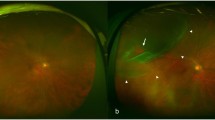Abstract
The prompt detection and proper evaluation of necrotic retinal region are especially important for the diagnosis and treatment of acute retinal necrosis (ARN). The potential application of artificial intelligence (AI) algorithms in these areas of clinical research has not been reported previously. The present study aims to create a computational algorithm for the automated detection and evaluation of retinal necrosis from retinal fundus photographs. A total of 149 wide-angle fundus photographs from 40 eyes of 32 ARN patients were collected, and the U-Net method was used to construct the AI algorithm. Thereby, a novel algorithm based on deep machine learning in detection and evaluation of retinal necrosis was constructed for the first time. This algorithm had an area under the receiver operating curve of 0.92, with 86% sensitivity and 88% specificity in the detection of retinal necrosis. For the purpose of retinal necrosis evaluation, necrotic areas calculated by the AI algorithm were significantly positively correlated with viral load in aqueous humor samples (R2=0.7444, P<0.0001) and therapeutic response of ARN (R2= 0.999, P<0.0001). Therefore, our AI algorithm has a potential application in the clinical aided diagnosis of ARN, evaluation of ARN severity, and treatment response monitoring.
Abstract
目的
探讨人工智能技术评估急性视网膜坏死病灶的有效性和准确性。
创新点
本研究首次将人工智能技术应用于急性视网膜坏死的诊治, 有利于减少该疾病的误诊率, 以及弥补治疗前后定量分析的空白。
方法
随机选取眼科就诊的急性视网膜坏死患者32人41眼, 收集149张眼底广角眼底拍照, 眼科专家对数据进行标注, 选取合适的模型建模, 数据集学习, 训练, 评估, 评估学习训练后的人工智模型在识别视网膜坏死区域的准确性, 敏感性和特异性。观察和比较临床治疗前后模型识别的视网膜坏死灶面积改变, 并分析其与房水病毒载量的关系。
结论
人工智能在急性视网膜坏死的诊疗中具有良好的应用价值, 值得进一步研究和推广。
Similar content being viewed by others

References
Asano S, Yoshikawa T, Kimura H, et al., 2004. Monitoring herpesviruses DNA in three cases of acute retinal necrosis by real-time PCR. J Clin Virol, 29(3):207–210. https://doi.org/10.1016/s1386-6532(03)00162-8
Bernheim D, Germi R, Labetoulle M, et al., 2013. Time profile of viral DNA in aqueous humor samples of patients treated for varicella-zoster virus acute retinal necrosis by use of quantitative real-time PCR. J Clin Microbiol, 51(7):2160–2166. https://doi.org/10.1128/JCM.00294-13
Bonfioli AA, Eller AW, 2005. Acute retinal necrosis. Semin Ophthalmol, 20(3):155–160. https://doi.org/10.1080/08820530500232027
Calvo CM, Khan MA, Mehta S, et al., 2017. Correlation of clinical outcomes with quantitative polymerase chain reaction DNA copy number in patients with acute retinal necrosis. Ocul Immunol Inflamm, 25(2):246–252. https://doi.org/10.3109/09273948.2015.1115081
Culbertson WW, Blumenkranz MS, Haines H, et al., 1982. The acute retinal necrosis syndrome: Part 2: histopathology and etiology. Ophthalmology, 89(12):1317–1325. https://doi.org/10.1016/s0161-6420(82)34638-2
de Fauw J, Ledsam JR, Romera-Paredes B, et al., 2018. Clinically applicable deep learning for diagnosis and referral in retinal disease. Nat Med, 24(9):1342–1350. https://doi.org/10.1038/s41591-018-0107-6
Falk T, Mai D, Bensch R, et al., 2019. U-Net: deep learning for cell counting, detection, and morphometry. Nat Methods, 16(1):67–70. https://doi.org/10.1038/s41592-018-0261-2
Gulshan V, Peng L, Coram M, et al., 2016. Development and validation of a deep learning algorithm for detection of diabetic retinopathy in retinal fundus photographs. JAMA, 316(22):2402–2410. https://doi.org/10.1001/jama.2016.17216
Hillenkamp J, Nölle B, Bruns C, et al., 2009. Acute retinal necrosis: clinical features, early vitrectomy, and outcomes. Ophthalmology, 116(10):1971–1975.e2. https://doi.org/10.1016/j.ophtha.2009.03.029
Holland GN, Executive Committee of the American Uveitis Society, 1994. Standard diagnostic criteria for the acute retinal necrosis syndrome. Am J Ophthalmol, 117(5): 663–666. https://doi.org/10.1016/s0002-9394(14)70075-3
Kanagasingam Y, Xiao D, Vignarajan J, et al., 2018. Evaluation of artificial intelligence-based grading of diabetic retinopathy in primary care. JAMA Netw Open, 1(5):e182665. https://doi.org/10.1001/jamanetworkopen.2018.2665
Kermany DS, Goldbaum M, Cai WJ, et al., 2018. Identifying medical diagnoses and treatable diseases by image-based deep learning. Cell, 172(5):1122–1131.e9. https://doi.org/10.1016/j.cell.2018.02.010
LeCun Y, Bengio Y, Hinton G, 2015. Deep learning. Nature, 521(7553):436–444. https://doi.org/10.1038/nature14539
Miserocchi E, Iuliano L, Fogliato G, et al., 2019. Bilateral acute retinal necrosis: clinical features and outcomes in a multicenter study. Ocul Immunol Inflamm, 27(7):1090–1098. https://doi.org/10.1080/09273948.2018.1501494
Puri I, Cox DD, 2018. A system for accurate tracking and video recordings of rodent eye movements using convolutional neural networks for biomedical image segmentation. Proceedings of 2018 40th Annual International Conference of the IEEE Engineering in Medicine and Biology Society, p.3590-3593. https://doi.org/10.1109/EMBC.2018.8513072
Risseeuw S, de Boer JH, ten Dam-van Loon NH, et al., 2019. Risk of rhegmatogenous retinal detachment in acute retinal necrosis with and without prophylactic intervention. Am J Ophthalmol, 206:140–148. https://doi.org/10.1016/j.ajo.2019.05.023
Schaal S, Kagan A, Wang YJ, et al., 2014. Acute retinal necrosis associated with Epstein-Barr virus: immunohistopathologic confirmation. JAMA Ophthalmol, 132(7):881–882. https://doi.org/10.1001/jamaophthalmol.2014.266
Sims JL, Yeoh J, Stawell RJ, 2009. Acute retinal necrosis: a case series with clinical features and treatment outcomes. Clin Exp Ophthalmol, 37(5):473–477. https://doi.org/10.1111/j.1442-9071.2009.02083.x
Acknowledgments
We are greatly indebted to all individuals who enrolled in our study as patients. This study was supported by the National Natural Science Foundation of China (Nos. 81870648 and 82070949).
Author information
Authors and Affiliations
Corresponding author
Additional information
Author contributions
Ke YAO, Jian WU, and Lei FENG conceived and designed the study. Lei FENG and Junhui SHEN conducted patient recruitment and clinical analysis. Daizhan ZHOU and Chenqi LUO performed the lab examinations and statistical analysis. Wenzhe WANG, Yifei LU, and Jian WU completed artificial intelligence architecture. Lei FENG wrote the manuscript. Ke YAO and Jian WU revised the manuscript. All authors have read and approved the final manuscript. Therefore, all authors have full access to all the data in the study and take responsibility for its integrity and security.
Compliance with ethics guidelines
Lei FENG, Daizhan ZHOU, Chenqi LUO, Junhui SHEN, Wenzhe WANG, Yifei LU, Jian WU, and Ke YAO declare that they have no conflicts of interest.
All procedures followed were in accordance with the ethical standards of the responsible committee on human experimentation (institutional and national) and with the Helsinki Declaration of 1975, as revised in 2008 (5). Informed consent was obtained from all patients for being included in the study. Additional informed consent was obtained from all patients for whom identifying information is included in this article.
Rights and permissions
About this article
Cite this article
Feng, L., Zhou, D., Luo, C. et al. Clinically applicable artificial intelligence algorithm for the diagnosis, evaluation, and monitoring of acute retinal necrosis. J. Zhejiang Univ. Sci. B 22, 504–511 (2021). https://doi.org/10.1631/jzus.B2000343
Received:
Accepted:
Published:
Issue Date:
DOI: https://doi.org/10.1631/jzus.B2000343



